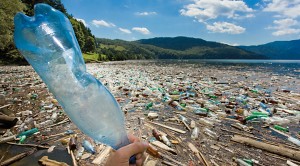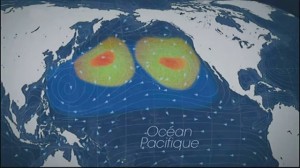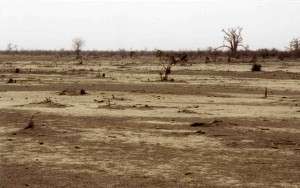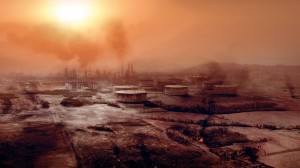Destruction of the environment
Since the beginning in the 19th century, mankind has changed the balance of nature and drastically degraded the foundations of life on earth and the prospects for our descendants’ future. Mother Earth is sinking in garbage and environmental damage. Clean water is growing increasingly scarce and valuable, and is already being described as “21st-century gold”. We are destroying our sources of food and cropland, so that the amount of food available for people and animals is decreasing constantly. Crops have been insufficient globally since 2000 and the battle for food and water has begun. Compounding this are the increasing number of global epidemics, such as AIDS, BSE, SARS, Ebola and swine flu, which cause the deaths of millions of people and animals.
Environmental pollution
“Environmental pollution” is a collective term for all forms of pollution of the natural habitats on earth. From a scientific point of view, it includes noise and light pollution, which I will not discuss further here. The three most common and serious forms of environmental pollution are water pollution, soil pollution and atmospheric pollution, each of which we will examine more closely.
Today, the emergence of environmental pollution is usually represented in five “developmental stages”; at each stage for over 200 years, the extent of the pollution has grown until we have reached the current level of global environmental and climate destruction.
1. Use of fire
2. Agriculture
3. Urban planning
4. Industrialization
5. Globalization
Water pollution
Water pollution encompasses the organic, industrial and toxic contamination of groundwater and surface water bodies such as rivers, lakes and oceans and of water cycles. The largest share of the pollution of water bodies in industrial and developing nations results from raw sewage from factories and cities and from improper functioning of obsolete sewer systems. Agriculture also contributes a huge amount to groundwater and surface water pollution, primarily due to the creation of artificially high levels of nutrients (eutrophication) from animal waste and fertilizers, resulting in such great concentrations that the levels of oxygen in bodies of water is reduced to the point that aquatic animals die, as does the water itself (hypoxia). This is in addition to the extreme concentrations of heavy metals which can be removed only partially and at high cost. All this is happening before our very eyes and despite the fact that “intentional water pollution” is illegal almost everywhere. Only the extreme cases are even prosecuted in Europe and in the USA; elsewhere, almost nothing is done.
Most contaminated flowing water on all continents ultimately reaches the oceans. This is in addition to the widespread piping of raw sewage, which has been practiced for centuries, and to oil pollution caused by transportation on the high seas. As though that were not enough, mountains of garbage have been “disposed of” on the open sea with increasing frequency for about 50 years. While this removes the garbage from our sight, it remains in the environment, causing new global problems.
Oceanography distinguishes between four categories of garbage:
– From industrial fishery, including lost nets and traps.
– From shipping traffic, which is also growing rapidly and often disposes of its waste by allowing it to run off into the water or throwing garbage overboard. Together, these two categories make up 20%.
– They are joined by finer waste and residues from sewage that is piped directly into the ocean.
– The vast majority reaches the ocean from the mainland, from garbage that is left on beaches and is carried into the ocean by wind and waves. Together, these two categories make up 80%.
This type of ocean pollution is insidious and often not directly observable. But the example of the “plastic continents” dramatically illustrates its effects. This garbage consists primarily of plastic from bags, packaging, bottles, tubes and disposable razors, none of which are biodegradable. They are merely broken up by the movement of the waves into ever-smaller particles and the smaller the plastic waste becomes, the more dangerous it is for the environment and for water quality. And, of course, for aquatic life; whales, fish and turtles die from eating the garbage, as do many birds which live on the smaller fish.
Soil pollution
Soil pollution is caused primarily by the huge mountains of garbage that are not burned but simply buried or piled up in garbage dumps. They contain many toxins, microorganisms and radioactive substances that break up and seep into the ground with rainwater, along with additives from the intensive agriculture and toxins from atmospheric pollution, which are also carried by falling rain.
Soil degradation by industrial agriculture has a much greater effect on our food chain. Its causes fall into four categories:
– Poor management in the course of monoculture agriculture, excessive agriculture, over irrigation and inadequate field drainage (salination).
– The destruction of vegetation cover by overgrazing, deforestation in industrial nations and slash-and-burn deforestation in developing nations (Amazon, Brazil).
– Degradation, compression and erosion of the soil structure by large machines and industrial livestock concentrations.
– Use of inorganic fertilizers and pollution by waste from households and industry.
These are further categorized into three types and their consequences:
– Biological soil degradation leads to the loss of biological diversity, the reduction of bioengineering and erosion.
– Chemical soil degradation leads to a decrease in carbon contained in the soil, increasing the CO2 content in the air. The pH value also changes, leading to sterility or soil salination, which prevents plants from absorbing water. Soil is also polluted with organic and inorganic toxins that kill the organisms in the soil and pollute the groundwater.
– Physical soil degradation is caused by soil compaction which destroys soil pores, and with them, the living space necessary for plants and organisms; soil surface sealing, which exacerbates flooding, since the water can no longer seep into the ground; and soil or humus layer depletion which makes the soil unusable for agriculture.
Air pollution
Air pollution encompasses changes in the natural composition of the air, usually due to smog, smoke, soot, toxic dust particles, gases, fumes, aerosols and odor emissions. All these fall under the category of air pollutants.
That may appear harmless, since many of them, unlike smoke emissions, are invisible, but the combination is literally deadly.
According to global studies carried out by the WHO in Geneva, over seven million deaths in 2012 were directly due to the consequences of air pollution; more than half of those were due to smog (a toxic mixture of concentrated airborne toxins in densely populated areas). This means that worldwide, one in eight deaths is due to polluted air.
The number of deaths due to air pollution has risen in the EU, too: in 2010, there were 406,000. That is six times as many as the 35,000 who died in traffic accidents in the same year. The damage caused by air pollution to people and the environment in the EU was 23 billion euro. The indirect costs were estimated to be between 330 and 940 billion euro, prompting action to be taken.
In most industrialized European countries, the local air pollution has fallen slightly in recent decades as a result of legal measures.
But in America, China and Russia, developing countries such as India and Brazil and in undeveloped nations, local and regional air pollution is significantly worse and continues to worsen, primarily because of coal-fired power plants.
Science recognizes three groups of air pollution: Substance-related according to causes, area-related according to effects and impact-related according to consequences.
The causes also fall into three categories (emitter groups): Energy production (power plants based on atomic fission, coal, gas and water), manufacturing (industry and animal husbandry) and transportation (passenger cars, cargo trucks, ships and planes).
In the following we will examine their primary emissions, share of all emissions and effects. Possible measures will be outlined under “What can we do” (636).
1. Energy generation
Power plants, particularly coal- and gas-driven ones. Power plants emit 21.3% of greenhouse gases (carbon dioxide, methane and nitrous oxides), more than any other source. Their main emissions are sulphur dioxide (SO2), which causes acid rain and forest deterioration and dieback.
2. Production
Industry causes 16.8% of emissions, of which the main one is carbon dioxide (CO2), which contributes to global warming.
Factory farming is described as an “agricultural byproduct” and causes 12.5% of emissions. But if it is taken together with the 10% accounted for by “land use and biomass combustion”, agriculture becomes the largest emitter at 22.5% of the total, more even than power plants and all traffic.
In addition, almost one third of the world’s crops — crops that could be used to feed undeveloped nations — are used as animal feed to fatten animals so that we can eat meat.
The main emission here is carbon dioxide (CO2), but agriculture is also the source of 85% of methane and 80% of nitrous oxide emissions; the greenhouse effects of both of these gases are significantly higher than that of carbon dioxide. Agriculture also produces ammonia (NH3) and the combination of these emissions exacerbates global warming and causes acid rain.
3. Traffic
The emissions from traffic are 14% of the total. If the 11.3% accounted for by fuel extraction is added, the total exceeds 25%. The main emissions from vehicle exhausts are nitrous gases (NOx), volatile organic compounds excluding methane (NMVOC), particulate emissions and various toxic particles. They exacerbate the greenhouse effect, acid rain, forest degradation and ozone formation.
– Traffic: Air pollution is primarily the result of urban traffic, which accounts for about 1/3 of traffic emissions.
– Ship traffic: The emissions of global seaborne traffic are just as high, causing another 1/3 of traffic emissions.
Seagoing vessels burn low-quality heavy fuel oil (HFO), a residue of oil refining, and usually have no exhaust filter.
– Air traffic: Kerosene is the fuel used by jet engines. But, like all fuels based on mineral oil, combustion of kerosene emits gases — the final 1/3 of all traffic emissions. This means that airplanes emit 650 million tons of CO2 and release one billion liters of kerosene into the atmosphere each year.
Climate pollution
Climate pollution or atmospheric pollution is caused primarily by air pollution and leads to global warming and contributes to the ozone hole.
Increasing climate pollution due to CO2
In 2011, 34 billion tons of carbon dioxide (CO2) entered the atmosphere from energy production, an increase of 3% over 2010. While European countries consistently try to reduce CO2 emissions, China, the U.S., Russia and developing countries have significantly increased theirs. China produced about 500 million tons, exceeding even the U.S. More than half of global emissions were caused by four countries: China (22.95%), the U.S. (18.5%), India (5.14%) and Russia (4.9%). By the emission of greenhouse gases, both the U.S. (24%) and Germany (14.5%) are performing worse than China (13.5%). And these are the very countries that are preventing effective climate policy.
Reduction of the ozone hole, which was caused by chlorofluorocarbons
The destruction of the ozone layer is a solid example of how we can affect the atmosphere over a long period of time without noticing it. The term “ozone hole” is used to refer to the extreme thinning of the protective ozone layer, especially over Antarctica. The cause of the ozone layer degradation was chlorine atoms from chlorofluorocarbons (CFCs) that have since been banned worldwide. The ozone hole, previously unknown to science, appeared every year from the beginning of the 1980s. A few weeks after the Arctic sunrise, the ozone concentration collapsed before recovering almost completely within a few months through toxins stored in ice crystals in stratospheric clouds. The thinning caused by chlorine atoms from our spray cans and refrigerants increased within only a few years from 5% to more than 50% and affected an area of several million square kilometers. The consequences are dramatic, because an ozone layer that is too thin at that point allows more UV-B rays to reach the earth, harming much Antarctic wildlife and causing the icecaps at the poles to melt faster.
This is just a small excerpt from the book GAIA LEGACY.




